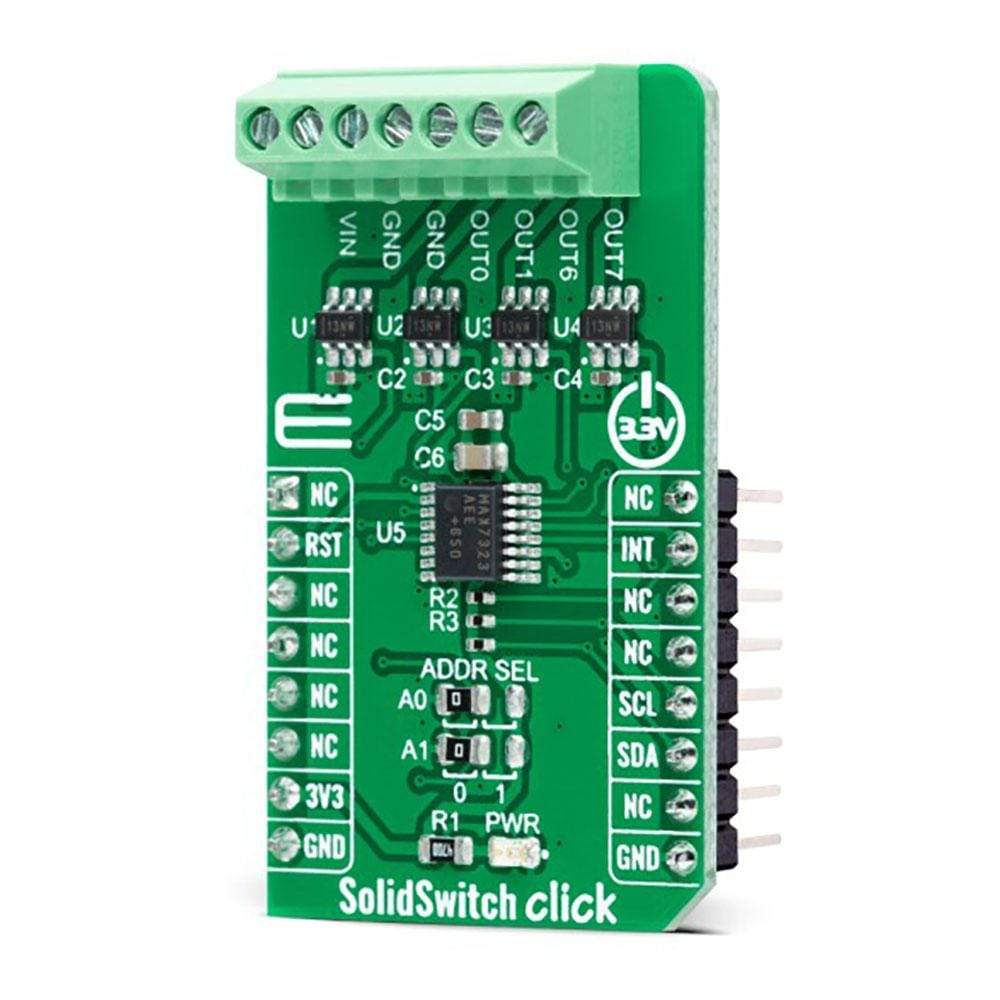
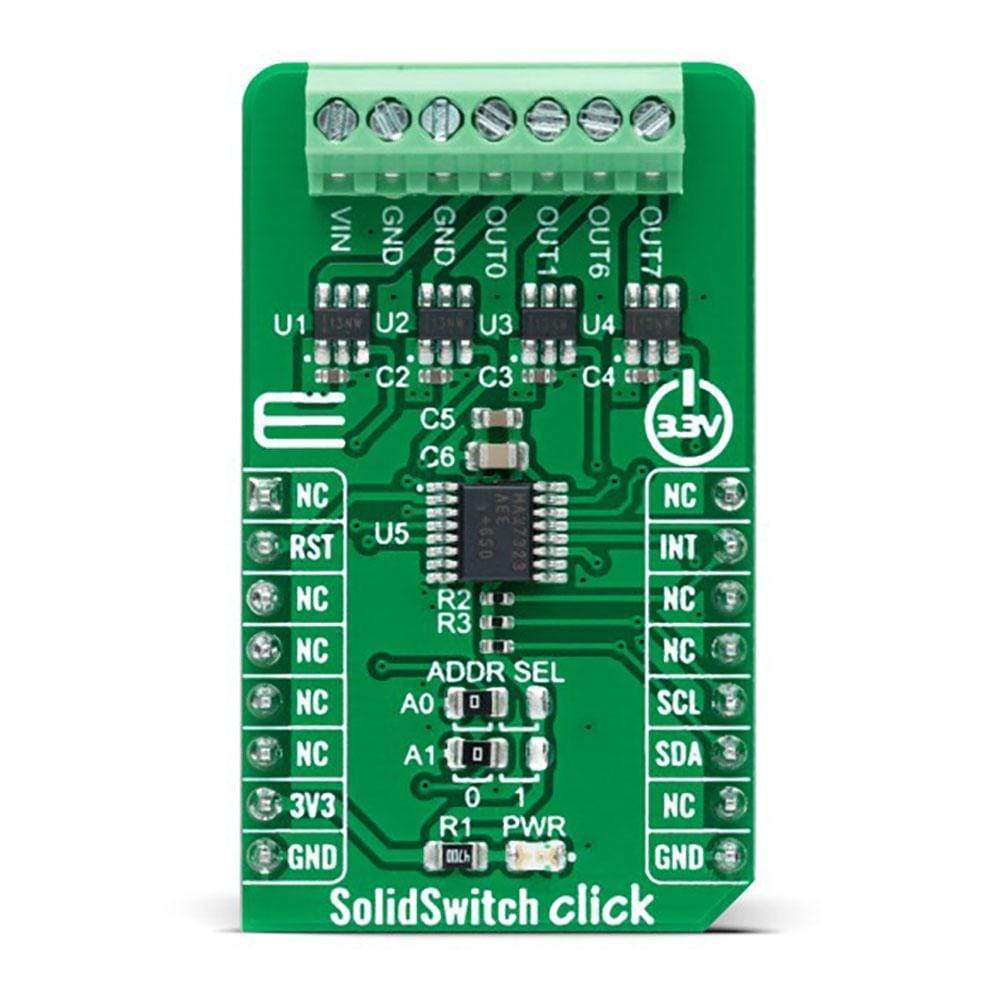
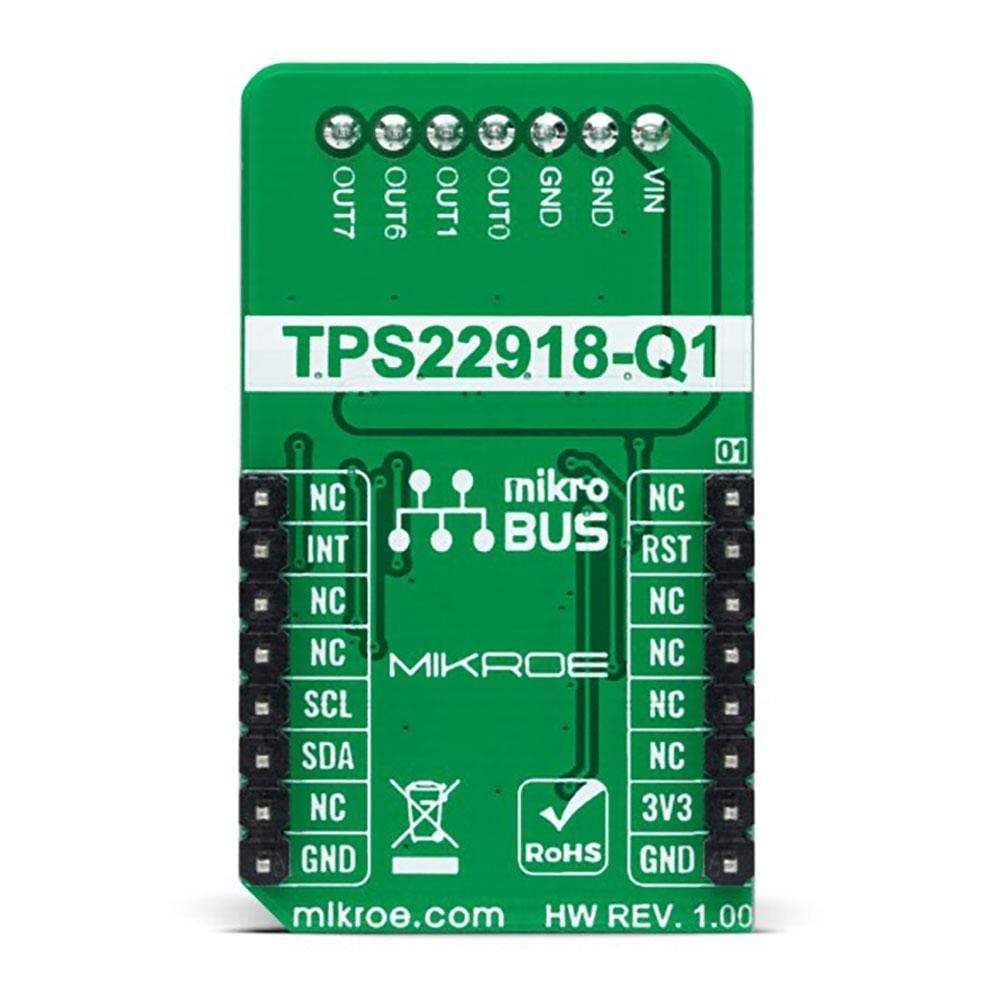
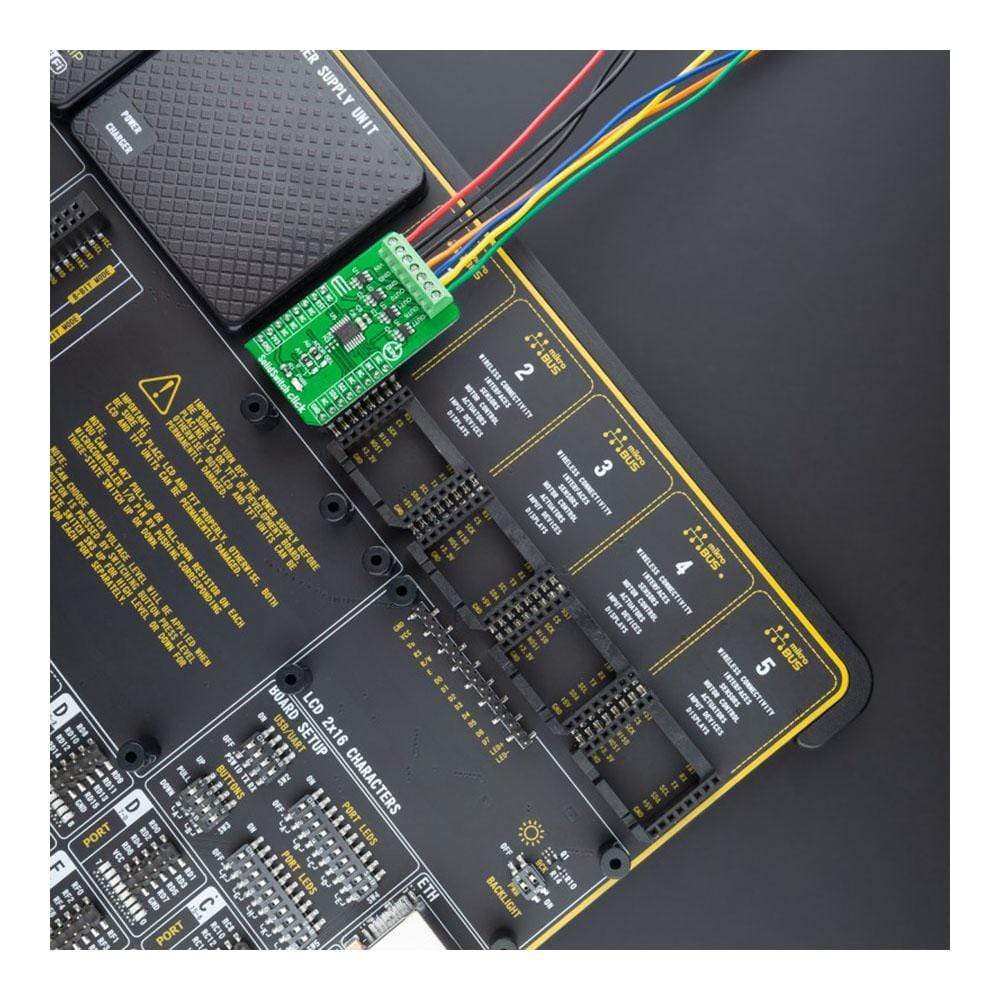

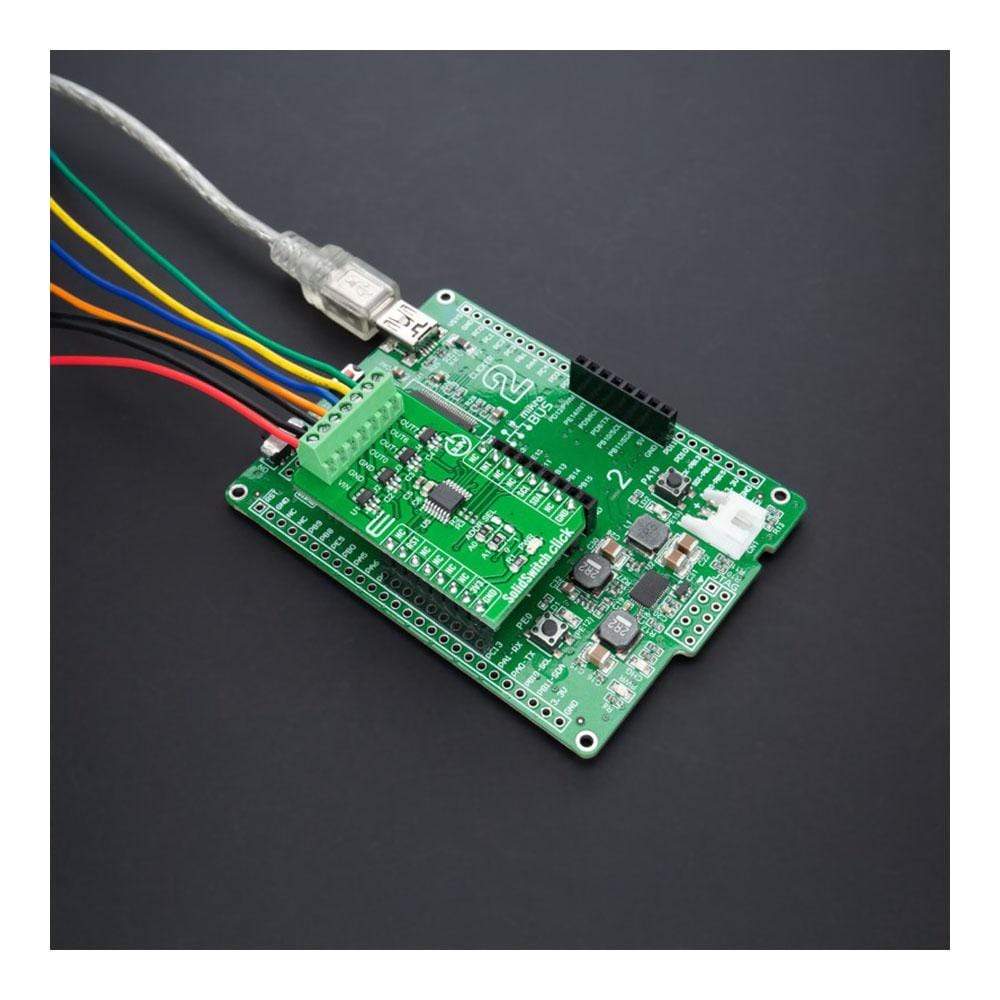
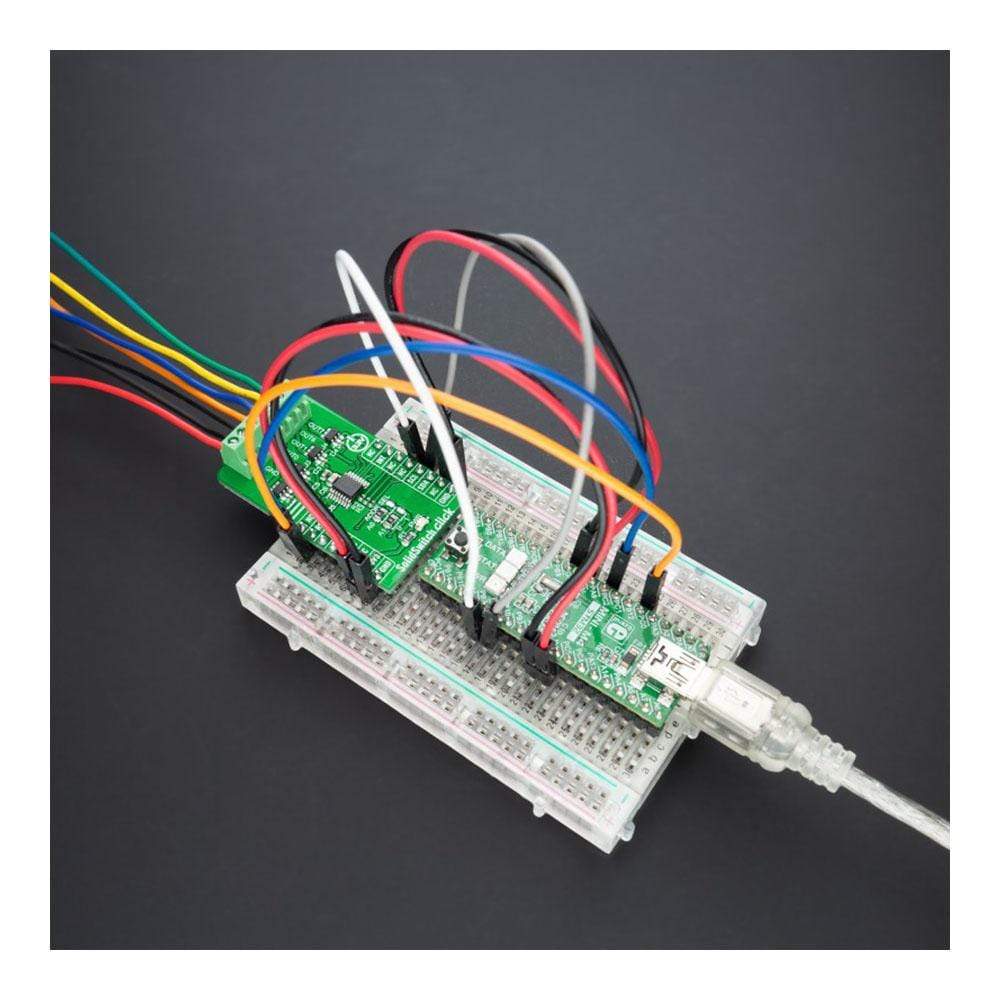
Overview
The SolidSwitch Click Board™ is a compact add-on board that contains load switch devices. This board features the TPS22918, four single-channel load switches from Texas Instruments. Every switch includes an N-channel MOSFET that operates over an input voltage range up to 5.5V and can support a maximum continuous current of 2 A. The switches are controlled by an ON/OFF input, performed by MAX7323, an I2C configurable port expander capable of interfacing directly with low-voltage control signals. This Click Board™ is suitable for industrial systems, set-top boxes, electronic point of scale, and various other applications.
The SolidSwitch Click Board™ is supported by a mikroSDK compliant library, which includes functions that simplify software development. This Click Board™ comes as a fully tested product, ready to be used on a system equipped with the mikroBUS™ socket.
Downloads
How Does The SolidSwitch Click Board™ Work?
The SolidSwitch Click Board™ is based on the TPS22918, a 5.5V 2A load switch from Texas Instruments. To reduce voltage drop for low voltage and high current rails, every TPS22918 implements a low resistance N-channel MOSFET, reducing the drop-out voltage across the device. An ON/OFF input on the ON pin of the TPS22918 controls the switches. The ON pin is compatible with the standard GPIO logic threshold and can be used with any MCU with 1V or higher GPIO voltage. That's why the control of all switches is established via the port expander, the MAX7323.
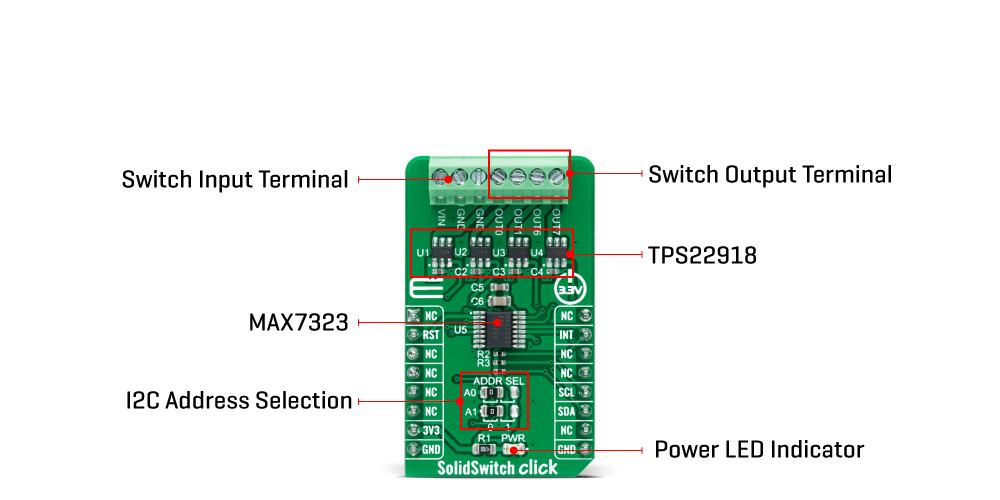
This Click board™ is designed to operate from an external supply voltage range from 1V to 5.5V. The TPS22918 works regardless of power sequencing order. The order in which voltages are applied to the VIN terminal and ON pin of the load switch will not damage the device as long as the voltages do not exceed the absolute maximum operating conditions.
The SolidSwitch Click Board™ communicates with MCU through the MAX7323 port expander using the standard I2C 2-Wire interface with a frequency of up to 400kHz. It also has two address pins (A0 and A1) programmed by the user to determine the value of the last two LSBs of the slave address, selected by onboard SMD jumpers labelled as ADDR SEL to an appropriate position marked as 0 and 1, allowing selection of the slave address LSBs. Also, this Click board™ has a Reset pin, routed to the RST pin on the mikroBUS™ socket, which clears the serial interface in case of a bus lockup, terminating any serial transaction to or from the MAX7323.
Also, it uses an additional pin, the INT pin of the mikroBUS™ socket, which automatically flags data changes on any of the I/O ports of the MAX7323 used as inputs. The interrupt output INT and all transition flags are deasserted when the MAX7323 is accessed through the serial interface.
The SolidSwitch Click Board™ can be operated only with a 3.3V logic voltage level. The board must perform appropriate logic voltage level conversion before use with MCUs with different logic levels. However, the Click board™ comes equipped with a library containing functions and an example code that can be used, as a reference, for further development.
SPECIFICATIONS
| Type | Relay |
| Applications | Can be used for industrial systems, set-top boxes, electronic point of scale, and various other applications. |
| On-board modules | TPS22918 - 5.5V 2A load switch from Texas Instruments |
| Key Features | Four integrated single channel load switches, flexible design, 2A maximum switch current, and more. |
| Interface | I2C |
| Compatibility | mikroBUS |
| Click board size | M (42.9 x 25.4 mm) |
| Input Voltage | 3.3V,External |
PINOUT DIAGRAM
This table shows how the pinout of the SolidSwitch Click Board™ corresponds to the pinout on the mikroBUS™ socket (the latter shown in the two middle columns).
| Notes | Pin |  |
Pin | Notes | |||
|---|---|---|---|---|---|---|---|
| NC | 1 | AN | PWM | 16 | NC | ||
| Reset | RST | 2 | RST | INT | 15 | INT | Interrupt |
| NC | 3 | CS | RX | 14 | NC | ||
| NC | 4 | SCK | TX | 13 | NC | ||
| NC | 5 | MISO | SCL | 12 | SCL | I2C Clock | |
| NC | 6 | MOSI | SDA | 11 | SDA | I2C Data | |
| Power Supply | 3.3V | 7 | 3.3V | 5V | 10 | NC | |
| Ground | GND | 8 | GND | GND | 9 | GND | Ground |
ONBOARD SETTINGS AND INDICATORS
| Label | Name | Default | Description |
|---|---|---|---|
| LD1 | PWR | - | Power LED Indicator |
| JP1-JP2 | ADDR SEL | Left | I2C Address Selection 0/1: Left position 0, Right position 1 |
SOLIDSWITCH CLICK ELECTRICAL SPECIFICATIONS
| Description | Min | Typ | Max | Unit |
|---|---|---|---|---|
| Supply Voltage VCC | - | 3.3 | - | V |
| Supply Voltage VIN | 1 | - | 5.5 | V |
| Maximum Output Current | - | - | 2 | A |
| Maximum On-Resistance | - | - | 52 | mΩ |
| Operating Temperature Range | -40 | +25 | +105 | °C |
| General Information | |
|---|---|
Part Number (SKU) |
MIKROE-4569
|
Manufacturer |
|
| Physical and Mechanical | |
Weight |
0.02 kg
|
| Other | |
Country of Origin |
|
HS Code Customs Tariff code
|
|
EAN |
8606027382284
|
Warranty |
|
Frequently Asked Questions
Have a Question?
Be the first to ask a question about this.







